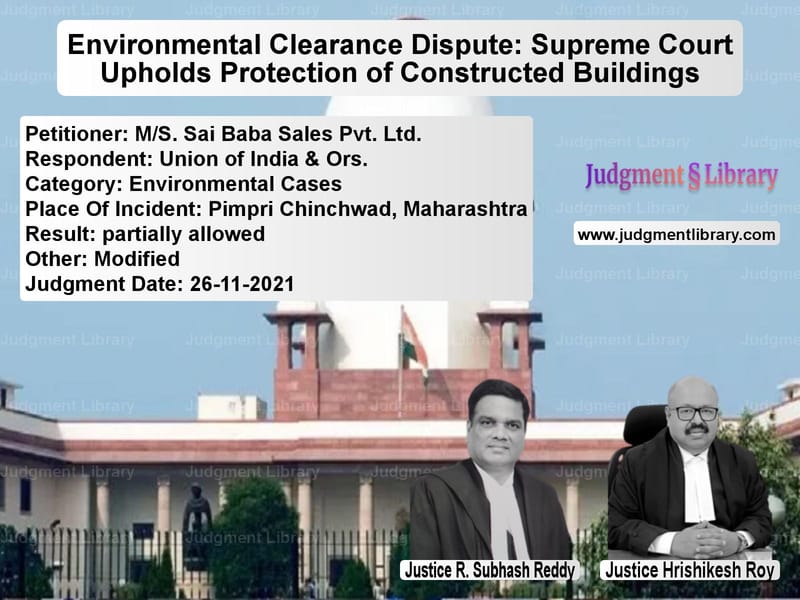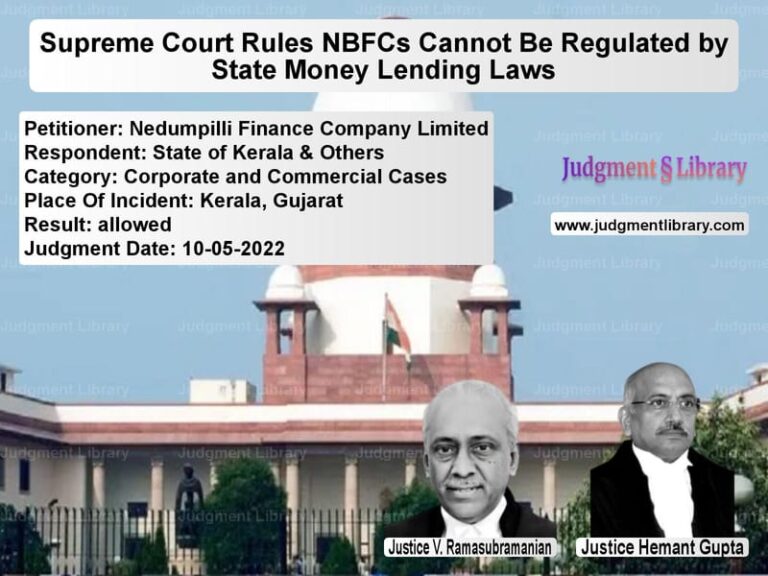Environmental Clearance Dispute: Supreme Court Upholds Protection of Constructed Buildings
The Supreme Court of India recently ruled in a case involving the validity of an environmental clearance (EC) granted to a construction project in Maharashtra. The case, M/S. Sai Baba Sales Pvt. Ltd. vs. Union of India & Ors., dealt with the question of whether a project proponent who had obtained EC from a municipal authority could be held liable after certain environmental regulations were struck down by the National Green Tribunal (NGT).
Background of the Case
The case arose when M/S. Sai Baba Sales Pvt. Ltd., a real estate developer, obtained an EC for constructing a project in Pimpri Chinchwad, Maharashtra. The approval was granted by the Environmental Cell of the Pimpri Chinchwad Municipal Corporation (PCMC) under a revised environmental impact assessment (EIA) notification dated 9.12.2016. This notification allowed local municipal bodies to issue ECs for projects with built-up areas between 20,000 and 50,000 sq. meters, instead of requiring clearance from the State Environment Impact Assessment Authority (SEIAA).
However, the NGT later quashed certain provisions of the 2016 notification in a separate case. This ruling led to a legal challenge against the EC granted to Sai Baba Sales Pvt. Ltd. The matter was taken to the NGT, which ruled that the project’s EC was invalid and directed the authorities to take action against the developer. The company, in turn, appealed to the Supreme Court, arguing that it had complied with all legal requirements at the time of construction.
Petitioner’s Arguments (Sai Baba Sales Pvt. Ltd.)
The project proponent contended that:
- The EC was obtained following due process as per the prevailing legal framework in 2017.
- They acted in good faith, adhering to all statutory requirements before the NGT’s judgment invalidating the 2016 notification.
- The company had already completed significant portions of the construction based on the approvals received.
- The NGT’s ruling should not retrospectively affect projects that had already received EC and made substantial progress.
- Invalidating the EC at this stage would cause severe financial loss and disrupt third-party rights of buyers who had purchased apartments in the project.
Respondent’s Arguments (Union of India & Others)
The Union of India and the complainant before the NGT argued that:
- The EC issued by PCMC was invalid because the NGT had already struck down parts of the 2016 notification.
- The project proponent should have sought fresh EC from SEIAA after the NGT’s ruling.
- Allowing the project to continue without a valid EC would set a dangerous precedent, undermining environmental laws.
- The government of Maharashtra had also issued clarifications post-2018, directing municipal bodies to stop granting ECs.
Supreme Court’s Observations
The Supreme Court carefully examined the legal and factual aspects of the case, making several key observations:
1. Doctrine of Legitimate Expectation
The Court ruled that since the project proponent had received EC under the legally recognized process at the time, they had a legitimate expectation that the approval would remain valid. It stated:
“When a public authority has promised to follow a certain procedure, it is in the interest of good administration that it should act fairly and should implement its promise, so long as implementation does not interfere with its statutory duty.”
2. Protection of Constructed Buildings
The Court upheld the NGT’s decision to protect the already constructed buildings, stating:
“Buildings already constructed in accordance with the EC granted at the relevant time should not be impacted by subsequent changes in the legal framework.”
3. Requirement for Fresh Environmental Clearance
The Court agreed with the NGT that any further construction beyond what was already built should require a fresh EC from SEIAA. It clarified:
“While the constructed buildings are protected, no additional construction shall take place without obtaining clearance from the competent authority under the prevailing regulatory framework.”
Final Judgment
The Supreme Court ruled:
- The already constructed buildings under the EC granted by PCMC are valid and protected.
- No further construction is permitted without obtaining fresh environmental clearance from SEIAA.
- The doctrine of legitimate expectation applies, as the project proponent complied with the legal framework existing at the time of approval.
- The judgment ensures that developers are not unfairly penalized for regulatory changes beyond their control.
Impact of the Judgment
This ruling sets an important precedent for future cases involving changes in environmental regulations:
- Developers who acted in good faith under the legal framework of their time are protected.
- Regulatory bodies must provide clear guidance to avoid retrospective penalization of projects.
- Future construction projects will need to adhere to stricter environmental scrutiny.
- Buyers and investors in large-scale real estate projects gain assurance about the stability of approvals.
Conclusion
The Supreme Court’s decision in this case strikes a balance between environmental protection and the rights of developers who followed the prevailing laws. By protecting already constructed buildings while ensuring fresh approvals for future construction, the Court provides clarity in a complex legal landscape. The ruling reaffirms the principle that regulatory changes should not retrospectively harm those who acted lawfully.
Petitioner Name: M/S. Sai Baba Sales Pvt. Ltd..Respondent Name: Union of India & Ors..Judgment By: Justice R. Subhash Reddy, Justice Hrishikesh Roy.Place Of Incident: Pimpri Chinchwad, Maharashtra.Judgment Date: 26-11-2021.
Don’t miss out on the full details! Download the complete judgment in PDF format below and gain valuable insights instantly!
Download Judgment: ms.-sai-baba-sales-vs-union-of-india-&-ors-supreme-court-of-india-judgment-dated-26-11-2021.pdf
Directly Download Judgment: Directly download this Judgment
See all petitions in Environmental Cases
See all petitions in Public Interest Litigation
See all petitions in Judgment by R. Subhash Reddy
See all petitions in Judgment by Hrishikesh Roy
See all petitions in partially allowed
See all petitions in Modified
See all petitions in supreme court of India judgments November 2021
See all petitions in 2021 judgments
See all posts in Environmental Cases Category
See all allowed petitions in Environmental Cases Category
See all Dismissed petitions in Environmental Cases Category
See all partially allowed petitions in Environmental Cases Category







